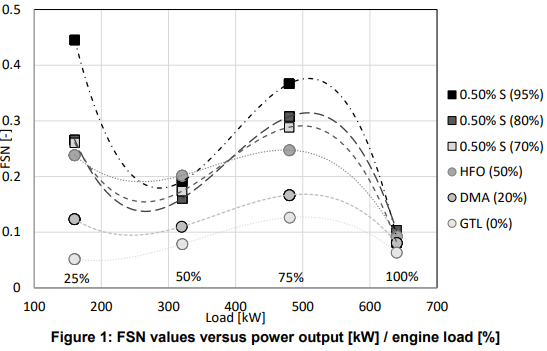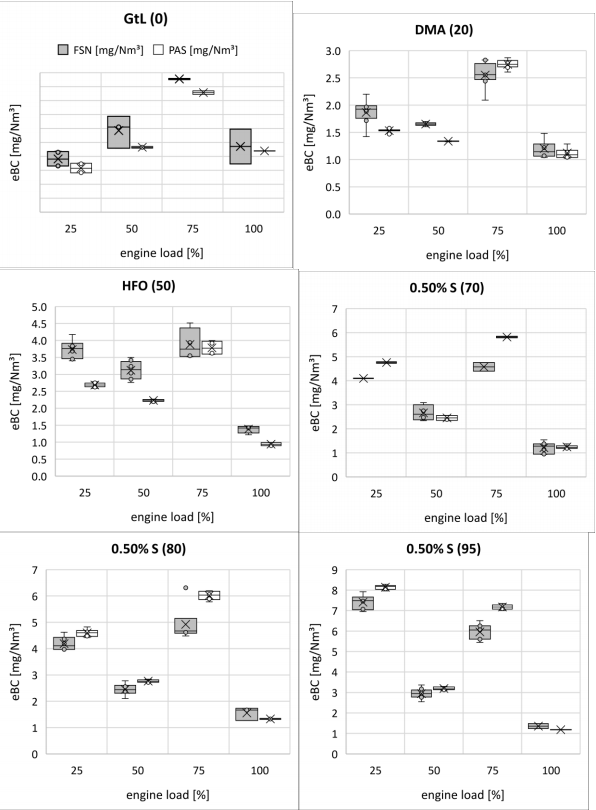- German government study highlights black carbon emission from 2020 fuels
- High aromatic compounds in the new blends causing 85% black carbon emission.
- Pressure mounting on IMO to take measures on new blends.
- Clean Shipping Alliance calls for an immediate switch to distillates.
- Clean Shipping Alliance questions how the ‘Frankenstein Fuels’ entered the market.
- Questions raised on the fuel industry’s awareness and why production isn’t stopped yet.
- The study stressed on the need to follow the strict ISO 8217 aromatic content and H/C ratio content guideline.
According to an article published in Safety4Sea, Finland and Germany submitted a study to the IMO’s Pollution Prevention and Response (PPR) sub-committee, in order to be revised during its session scheduled for February.
Black Carbon Emission Study
- This document presents the results of a measurement campaign for the analysis of the impact of fuel oil quality on Black Carbon emissions.
- The results indicate that new blends of marine fuels with 0.50% sulphur content can contain a large percentage of aromatic compounds, which have a direct impact on Black Carbon emissions.
- Germany has therefore conducted a BC measurement campaign with two of the three identified appropriate BC measurement methods (FSN and PAS) to analyse the impact of different fuel oil qualities on BC emissions.
- The measurement campaign was conducted by WTZ Roßlau and was assisted by MAN ES, DNV GL and Marena Ltd. The project was funded by the German Environment Agency.
IMO Under Pressure To Act
Meanwhile, media reports on Monday highlighted how pressure is mounting on IMO to act on this Black Carbon Emissions immediately.
“New hybrid fuels with 0.50% sulphur content used in the study contained a high proportion of aromatic compounds in a range of 70% to 95%, which resulted in increased [black carbon] emissions in a range of 10% to 85% compared to HFO,” the German study sent to the IMO claimed. The higher emissions were most noticeable when the engine was running at less than full capacity.
Immediate Switch To Distillates
The Clean Arctic Alliance has today called for the IMO to support an immediate switch to distillate fuels for ships in the Arctic and develop a global rule prohibiting fuels with high black carbon emissions.
“If immediate action isn’t taken by the International Maritime Organization, the shipping industry’s use of VLSFO – introduced to comply with the 2020 sulphur cap – will lead to a massive increase in black carbon emissions, and this will both accelerate the melting of Arctic sea ice and have a major impact on Earth’s climate,” said Dr Sian Prior, lead Aadvisor to the Clean Arctic Alliance.
Also demanding a fuel change today is John Maggs, senior policy advisor at Seas at Risk, who questioned how VLSFO was allowed to be created in the first place.
“There are serious questions to be answered about how these blended super pollutant Frankenstein fuels ever came to market. It beggars belief that amidst a global climate crisis, the marine fuel industry could develop these VLSFOs without knowing their effect on black carbon emissions and the climate, particularly in the Arctic – especially as the IMO has spent almost a decade considering how to reduce black carbon emissions from shipping,” Maggs said today.
The Clean Arctic Alliance has written a letter containing the following questions to representatives of the marine fuel industry who prepared the definitive guidance on the supply and use of 0.5% sulphur marine fuel, to ask if they were aware that these new low sulphur heavy fuel blends had higher aromatic content, and if they were aware of the link between higher aromatic content in fuels and higher black carbon emissions?
“If the answer to the above questions is ‘yes’, then why did you not immediately seek to halt the production of these fuels and alert the IMO?,” the NGO questioned in its letter.
The letter was sent to IACS, IBIA, IPIECA, IMarEST, IUMI, OCIMF, and the Royal Institute of Naval Architects – all of whom have consultative status to the IMO. The letter was also sent to ARA, Concawe, CIMAC and JPEC. All of the organisations are named as co-authors of of the Joint Industry Guidance on the supply and use of 0.50%-sulphur marine fuel, published in August 2019.
The Black Carbon Measurement Campaign
Emphasis of the measurement campaign was to analyse the BC emissions of future hybrid fuels with 0.50% sulphur content from different sources and different production processes, in comparison to two conventional fuels, HFO and DMA, and a possible future synthetic Gas to Liquid (GtL) fuel, at varying engine ratings on a test bed.
The tested 0.50% sulphur fuels have been ordered as possible sample mixtures from refinery-streams most likely to be used in 2020. A high aromatic content in future low sulphur marine fuels after 2020 is expected.
The range of measurement values was very low and narrow for the different fuels at 100% engine load followed by 50% load.At 75% load, the spread of the FSN data from different fuels continues to increase, while at 25% load, the FSN data show the largest differences for the different fuels.
For a better visualization, the BC emissions are presented separately for each fuel as box and whisker plots in the following figure. The box plots are statistical graphs, where the boxes include the upper and lower quartiles (25-75% of the data).
The BC emissions in this study are in a range between 0.56 and 8.3 mg/Nm³. The lowest BC emissions have been observed at 100% engine load for all fuels below 2 mg/Nm³. The highest BC emissions were generally detected at 75% and 25% engine load. The 0.50% sulphur fuel with 95% aromatic compounds showed the highest BC emissions at 25% load with 8 mg/Nm³, followed by 75% load with 7 mg/Nm³.
The 25% load point had the highest differences in BC emissions between the fuels with the following order (in brackets: aromatic compounds): GtL (0%) < DMA (20%) < HFO (50%) < 0.50% sulphur (70%) < 0.50% sulphur (80%) < 0.50% sulphur (95%). This order leads to the assumption that the concentration of aromatic compounds might have an impact on the BC emissions of the various fuels. Therefore, the BC data in figure 3 are plotted against the aromatic content to see if this hypothesis holds true.
Black Carbon Emission Trends
In addition, the eBC emissions for each engine load (25%, 50%, 75% and 100%) in relation to the aromatic content of the fuels (GTL 0%, DMA 20%, HFO 50%, 0.50% sulphur 70%, 80% and 95%):
- There is a clear trend for increasing BC emissions with increasing aromatic content in the fuels with correlation coefficients for the PAS data of 0.86; 0.98 and 0.97 for 25%, 50% and 75% engine load, respectively. For the 100% engine load there was no clear trend, possibly due to the comparatively low BC emissions;
- For the 50% engine load, the FSN BC data for HFO (50% aromatic content) deviate upwards from the linear trend as compared to the PAS data, while for the 75% load, the FSN BC data for the 0.50% sulphur fuels deviate downwards;
- The BC emissions are also influenced by the engine load, with 100% showing the lowest and 75% and 25% showing the highest BC emissions. Furthermore, the spread of the data is much wider for 75% and 25% load as compared to the other engine loads.
Conclusions
The study concluded the following results:
- The PAS instrument measured higher BC emissions for the three 0.50% sulphur fuels as the FSN, while the FSN measured higher BC emissions for the GtL and HFO fuels. For DMA, both instruments agreed well. The FSN data showed a slightly higher scattering than the PAS data and the reproducibility was slightly higher for the PAS instrument;
- The measurement study has demonstrated that the combustion of fuels with higher aromatic content emits higher concentrations of BC. New hybrid fuels with 0.50% sulphur content used in the study contained a high proportion of aromatic compounds in a range of 70% to 95%, which resulted in increased BC emissions in a range of 10% to 85% compared to HFO and in a range of 67% to 145% (a factor of 2.45) compared to DMA;
- The results of this measurement campaign imply that it is necessary to implement aromatic content, or H/C ratio, in the specification of marine fuels of the ISO 8217 petroleum standard. This would enable a better qualification of marine fuels with respect to their environmental performance in terms of BC emissions and benefit their characterization for ignition and combustion quality. It is suggested that the International Organization for Standardization review ISO 8217 to include specifications taking into account these results.
Did you subscribe to our daily newsletter?
It’s Free! Click here to Subscribe!
Source: Safety4Sea


























The scam of climate change – scare mongering is getting out of hand. No carbon foot print means no life.
In the trade-off between human lives and environment anybody who values his life should side with human life and happiness.
And
the eco-terrorists will never be satisfied until human existence is obliterated from our planet.